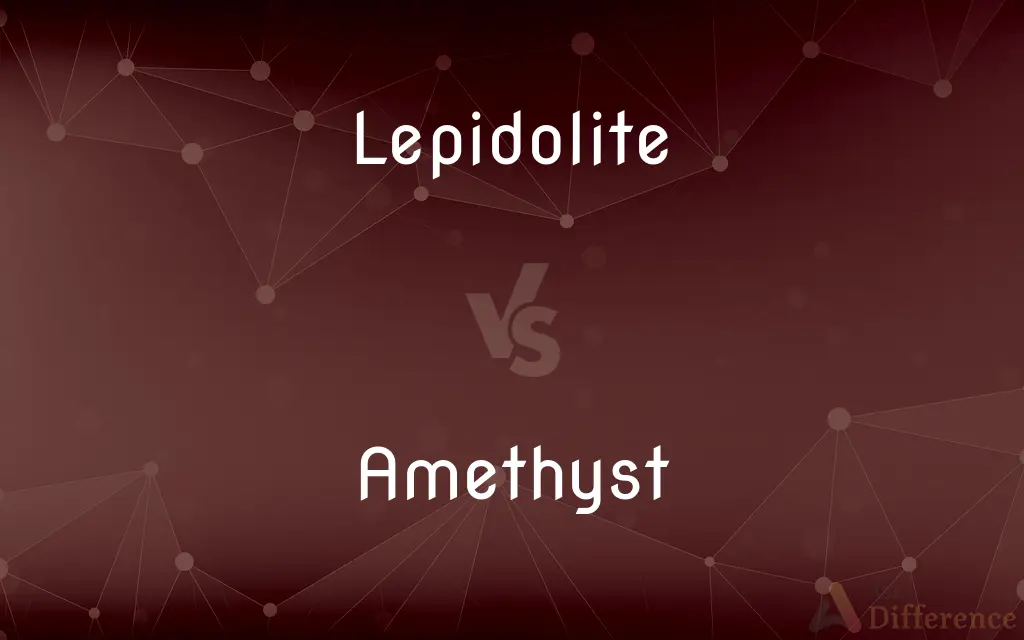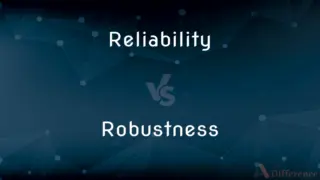Lepidolite vs. Amethyst — What's the Difference?
By Tayyaba Rehman & Maham Liaqat — Updated on April 15, 2024
Lepidolite is a lithium-rich mica known for its lilac hues, whereas amethyst, a type of quartz, is famed for its rich purple color and crystal clarity.

Difference Between Lepidolite and Amethyst
Table of Contents
ADVERTISEMENT
Key Differences
Lepidolite is a mineral belonging to the mica group and is primarily identified by its high lithium content and soft, layered structure. Whereas, amethyst is a variety of quartz that is characterized by its distinct purple coloration, which can range from light lavender to deep violet.
Lepidolite often exhibits a pearly luster and can appear in various shades from pink to purple, depending on its chemical composition. On the other hand, amethyst has a glassy luster and its purple color is typically uniform, which is caused by irradiation and iron impurities in the quartz.
In terms of hardness, lepidolite is quite soft, rating a 2.5 to 3 on the Mohs scale, which makes it susceptible to scratching and not ideal for jewelry that requires durability. Amethyst, however, is much harder, with a rating of 7 on the Mohs scale, making it suitable for various types of jewelry.
Lepidolite is often mined for its lithium content, which is used in the manufacture of batteries and mental health medications. Whereas amethyst has been highly valued throughout history both for its beauty and purported healing properties, which include stress relief and the promotion of clarity.
While lepidolite is typically found in granite pegmatites and is less commonly known in the gem world, amethyst is found in geodes and volcanic rocks and is one of the most popular and recognizable gemstones globally.
ADVERTISEMENT
Comparison Chart
Composition
Lithium-rich mica
Silicon dioxide (quartz)
Color
Pink, purple, lilac
Purple, ranging from light to deep
Luster
Pearly
Glassy
Hardness
2.5-3 (Mohs scale)
7 (Mohs scale)
Primary Uses
Mineral extraction, decorative
Jewelry, decorative, healing crystal
Compare with Definitions
Lepidolite
Noted for its pearly luster and flaky texture.
The pearly sheen of lepidolite gives it a distinctive look among minerals.
Amethyst
Popular in jewelry and decorative arts for its beauty and durability.
Amethyst is a favorite choice for earrings due to its hardness.
Lepidolite
Used in manufacturing due to its lithium content.
Lepidolite is processed to extract lithium for use in batteries.
Amethyst
A type of quartz characterized by its purple coloration.
Amethyst ranges in color from pale lavender to deep violet.
Lepidolite
A lithium-rich mica mineral known for its lilac to purple hues.
Lepidolite is commonly found in pegmatites alongside other lithium-bearing minerals.
Amethyst
Believed to have metaphysical properties that promote clarity and calm.
Many people wear amethyst necklaces to help relieve stress.
Lepidolite
Considered a healing stone in metaphysical practices.
Lepidolite is often used in crystal healing for stress relief.
Amethyst
Found in volcanic rocks and geodes.
Large amethyst geodes are often displayed as natural art pieces.
Lepidolite
Soft and easily scratched, less ideal for wear.
Due to its softness, lepidolite is not commonly used in rings or bracelets.
Amethyst
Used historically as a gemstone of royalty.
Amethyst was once prized by Egyptian royalty for its striking appearance.
Lepidolite
Lepidolite is a lilac-gray or rose-colored member of the mica group of minerals with chemical formula K(Li,Al)3(Al,Si,Rb)4O10(F,OH)2. It is the most abundant lithium-bearing mineral and is a secondary source of this metal.
Amethyst
Amethyst is a violet variety of quartz. The name comes from the Koine Greek αμέθυστος amethystos from α- a-, "not" and μεθύσκω (Ancient Greek) methysko / μεθώ metho (Modern Greek), "intoxicate", a reference to the belief that the stone protected its owner from drunkenness.
Lepidolite
A lilac or pink to gray mineral of the mica group, K(Li,Al)3(Si,Al)4O10(F,OH)2, used as lithium ore and in ceramic production.
Amethyst
A precious stone consisting of a violet or purple variety of quartz
Amethyst earrings
A delicate necklace of amethysts and pearls
Lepidolite
(mineral) A pale lilac mica mineral that is a mixed basic fluoride and aluminosilicate of potassium, lithium and aluminium.
Amethyst
A purple or violet form of transparent quartz used as a gemstone.
Lepidolite
A species of mica, of a lilac or rose-violet color, containing lithia. It usually occurs in masses consisting of small scales. See Mica.
Amethyst
A purple variety of corundum used as a gemstone.
Lepidolite
A mineral of the mica group; an important source of lithium
Amethyst
A moderate purple to grayish reddish purple.
Amethyst
A transparent purple variety of quartz, used as a gemstone.
Amethyst
(uncountable) A purple colour.
Amethyst
(tincture) The tincture purpure, when emblazoning the arms of the English nobility.
Amethyst
Having a colour similar to that of the gemstone
Amethyst
A variety of crystallized quartz, of a purple or bluish violet color, of different shades. It is much used as a jeweler's stone.
Amethyst
A purple color in a nobleman's escutcheon, or coat of arms.
Amethyst
A transparent purple variety of quartz; used as a gemstone
Amethyst
Of a moderate purple color
Common Curiosities
Can lepidolite be used in everyday jewelry?
Lepidolite is not typically recommended for everyday jewelry due to its softness and susceptibility to damage.
What is lepidolite primarily used for?
Lepidolite is primarily used for extracting lithium and as a decorative stone.
What are the metaphysical properties of amethyst?
Amethyst is believed to promote clarity, calm, and stress relief in metaphysical practices.
How does the market value of lepidolite compare to amethyst?
Amethyst generally has a higher market value due to its popularity in jewelry, whereas lepidolite’s value is more linked to its industrial lithium content.
Why is amethyst considered valuable in jewelry making?
Amethyst is valued for its durability, beautiful purple color, and versatility in designs.
How does the hardness of lepidolite affect its use?
Due to its low hardness, lepidolite is more prone to scratching and is less ideal for frequently worn jewelry.
Can lepidolite and amethyst be used together in healing or decorative practices?
Yes, both can be used together in healing and decorative practices, complementing each other with lepidolite’s calming properties and amethyst’s focus on clarity and mental peace.
How do care requirements for lepidolite differ from amethyst?
Lepidolite requires careful handling due to its softness and susceptibility to water damage, while amethyst is more durable but should be protected from prolonged sun exposure to prevent color fading.
What causes the color variations in lepidolite and amethyst?
The color in lepidolite is influenced by the amount of lithium and sometimes traces of other minerals, while amethyst’s purple hue is due to iron impurities and irradiation.
Where are lepidolite and amethyst typically mined?
Lepidolite is mainly mined in pegmatite formations in countries like Brazil and Canada, whereas amethyst is found in geodes and volcanic areas, prominently in Brazil, Uruguay, and Madagascar.
Are there any historical significances associated with lepidolite and amethyst?
Lepidolite was discovered in the 18th century and used for its lithium for medicinal purposes, while amethyst has been used since ancient times, believed to prevent intoxication and symbolic of royalty.
What are some common forms or products that include lepidolite and amethyst?
Lepidolite is often used in small decorative items and crystal healing, while amethyst is commonly cut into gemstones for jewelry and large sculptural pieces as geodes.
How do the geological formations of lepidolite and amethyst differ?
Lepidolite forms in lithium-rich pegmatites as secondary mineral deposits, while amethyst forms primarily in volcanic rocks and sedimentary rocks.
Share Your Discovery

Previous Comparison
Rob vs. Burgle
Next Comparison
Reliability vs. RobustnessAuthor Spotlight
Written by
Tayyaba RehmanTayyaba Rehman is a distinguished writer, currently serving as a primary contributor to askdifference.com. As a researcher in semantics and etymology, Tayyaba's passion for the complexity of languages and their distinctions has found a perfect home on the platform. Tayyaba delves into the intricacies of language, distinguishing between commonly confused words and phrases, thereby providing clarity for readers worldwide.
Co-written by
Maham Liaqat















































